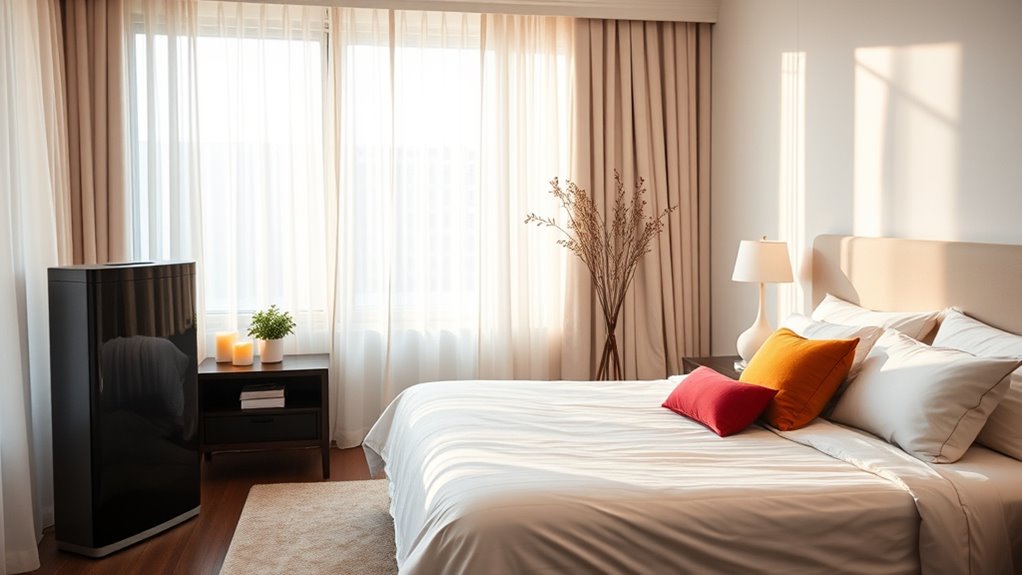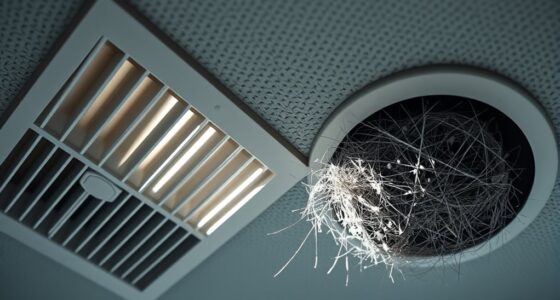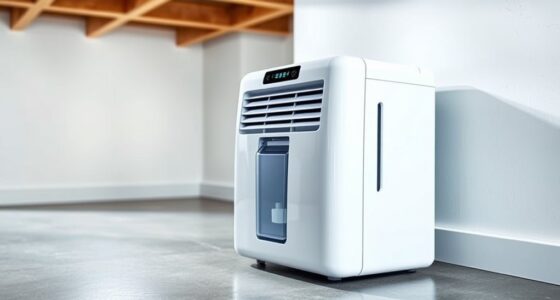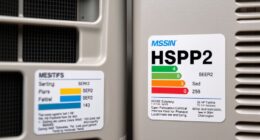To improve your bedroom air quality, start by adding an effective air purifier with a HEPA filter to remove allergens and pollutants. open windows daily to encourage natural ventilation, especially on days with good outdoor air quality. Maintain filters regularly, use cross-ventilation, and keep humidity in check to reduce mold and odors. Small adjustments like these can create a cleaner, healthier space, and exploring more tips can lead to even better results.
Key Takeaways
- Incorporate a high-quality HEPA air purifier to remove allergens, dust, and pet dander effectively.
- Regularly open windows to boost natural ventilation and dilute indoor pollutants.
- Schedule filter replacements and maintenance for your air purifier to maintain peak performance.
- Use cross-ventilation by opening windows on opposite sides for better airflow and pollutant dispersal.
- Monitor outdoor air quality to optimize ventilation times and prevent indoor pollution buildup.
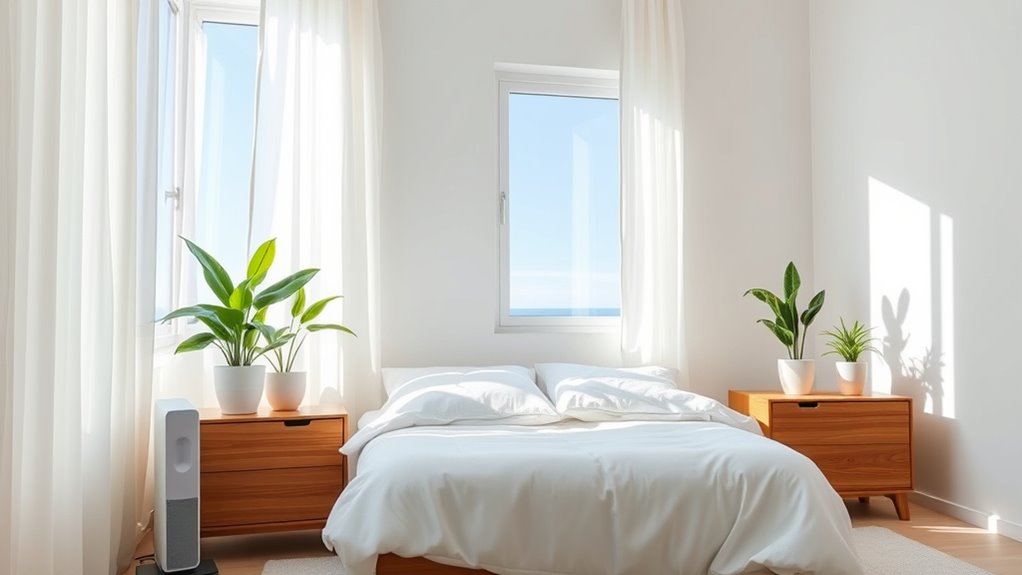
Your bedroom should be a sanctuary, but poor air quality can undermine your rest and overall health. One of the most effective ways to improve your indoor environment is by incorporating an air purifier. The benefits of using an air purifier extend beyond just freshening the air; they actively reduce allergens, dust, pet dander, and airborne pollutants that can trigger allergies or asthma. When you invest in an air purifier, you’re creating a cleaner, healthier space where you can breathe more easily and sleep more soundly. Look for models with HEPA filters, as they capture tiny particles that often go unnoticed but cause significant discomfort. Regularly replacing or cleaning the filters ensures your air purifier continues to work efficiently, maximizing its benefits.
A clean, healthy bedroom starts with an air purifier and regular filter maintenance.
Alongside using an air purifier, embracing natural ventilation techniques can dramatically enhance your bedroom’s air quality. Opening windows and doors allows fresh air to circulate, diluting indoor pollutants and bringing in oxygen-rich air from outside. If outdoor air quality isn’t ideal, consider strategic ventilation methods like cross-ventilation, where you open windows on opposite sides of your room, creating a breeze that sweeps away stale air. You can also use fans to facilitate airflow, but ensure they’re positioned to promote fresh air movement rather than recirculating indoor air. Consistent natural ventilation is a simple, cost-effective way to eliminate odors, reduce humidity, and prevent mold growth, all of which contribute to maintaining a healthier environment. Proper air exchange helps maintain optimal indoor air quality and reduces indoor pollutants.
Combining an air purifier with natural ventilation techniques gives you an even stronger advantage. While an air purifier filters and cleans the air indoors, natural ventilation keeps the air fresh and oxygenated. This synergy ensures that pollutants don’t build up over time and that your space remains consistently healthy. Remember, the key is balance—avoid over-relying on one method; instead, use both to complement each other. For example, on days when outdoor air quality is poor due to pollution or pollen, rely more on your air purifier. Conversely, on days with clear skies and gentle breezes, open your windows to bring in natural freshness.
Making these changes doesn’t require a complete overhaul of your space but involves thoughtful adjustments. By understanding the air purifier benefits and harnessing natural ventilation techniques, you can transform your bedroom into a true sanctuary. Better air quality leads to better sleep, improved mood, and overall well-being. Start small by adding an air purifier and opening your windows regularly, and observe how your environment—and your health—improves over time. Small, consistent steps make a significant difference in creating a bedroom that truly supports your rest and vitality.
Frequently Asked Questions
How Often Should I Replace My Air Filters for Optimal Bedroom Air Quality?
You should replace your air filter every 1 to 3 months to maintain ideal bedroom air quality. The air filter lifespan varies based on factors like dust levels, pet dander, and filter type. Stick to a consistent replacement schedule, checking monthly, especially during high pollen seasons or if you notice dust accumulating. Regular changes ensure your air stays clean, helping you breathe easier and improving overall sleep quality.
Can Indoor Plants Improve Bedroom Air Quality Effectively?
Indoor plants can effectively improve your bedroom air quality if you choose the right ones and maintain them properly. Regular plant maintenance, like watering and cleaning leaves, helps maximize their air-purifying benefits. However, if you have pets, make sure the plants are pet-safe, as some common houseplants can be toxic. With careful selection and upkeep, indoor plants can enhance your sleep environment and boost overall air freshness.
What Are the Best Natural Remedies to Reduce Indoor Allergens?
To reduce indoor allergens naturally, you should use natural remedies like beeswax candles to trap airborne particles, add air-purifying plants such as snake plants or aloe vera, and use natural fiber bedding that resists dust mites. Regularly vacuum with a HEPA filter, keep humidity low, and open windows for fresh air. These simple steps help decrease indoor allergens and improve your air quality effortlessly.
How Does Humidity Level Impact Sleep Quality and Air Quality?
Humidity control directly impacts your sleep comfort and air quality. When humidity levels are too high, mold and dust mites thrive, causing allergies and respiratory issues. Too low, and your air becomes dry, irritating your throat and skin. Maintaining a balanced humidity level around 40-50% helps you breathe easier, reduces allergens, and promotes better sleep. Use a humidifier or dehumidifier to keep your environment ideal for restful nights.
Are Air Purifiers Safe for Children and Pets in the Bedroom?
Air purifiers are generally safe for children and pets in the bedroom if you choose models with child safety features and pet-friendly filters. Always make certain the device has certifications like ENERGY STAR or CARB compliance. Keep the purifier out of reach of kids and pets to prevent accidents. Regularly clean and replace filters to maintain air quality and protect your child’s safety and pet health, creating a healthy sleeping environment.
Conclusion
Transforming your bedroom air quality is like tending a delicate garden—you nurture it with care, and it blooms into a sanctuary of freshness. By implementing these simple yet powerful changes, you’re not just improving air; you’re creating a haven where your well-being can flourish. Breathe deeply, knowing each mindful effort is the gentle breeze guiding you toward serenity. Your bedroom becomes a sanctuary of pure, revitalizing air—your personal oasis amid the chaos.
